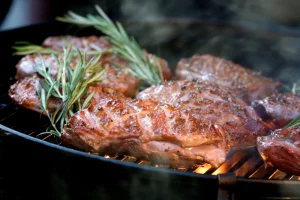
Quality seal for poultry
Quality is important to many people, even when it comes to food such as poultry. Not everyone is an expert at evaluating the quality of goods when shopping. Quality seals for poultry may also mean that certain conditions must be met during animal husbandry to even receive the seal. This is hardly verifiable for a customer in the store, which is why quality seals also provide security. Whether the requirements have actually been met is checked by independent authorities or inspectors. However, there are also non-legally regulated designations that are intended to give the impression of good quality or monitoring of housing and breeding conditions. Knowing the quality seals for poultry puts you at an advantage when buying poultry. Since poultry for grilling is very popular in Germany, we, the Grill Connoisseur Team, want to explain the most important ones. So you know what they mean and how to get good quality for grilling poultry. We also explain which designations have little or no significance.
Which Labels and Trading Classes Exist for Poultry in Germany?
The German trading class regulation divides poultry into five different categories. The following distinctions are made:
- Poultry
- Slaughtered poultry
- Poultry meat
- Poultry parts
- Poultry offal
The quality of the individual categories is assessed in three quality classes – Class A, B, or C. Class A is awarded for the best quality. Class B stands for average quality, and C brings up the rear. The classification of quality classes is based on important physical, optical, and sensory characteristics. The overall impression, the meat attachment of thigh or breast portions, and the fat cover are important evaluation criteria.
Defects in the flawless quality lead to deductions in the classification of quality classes, for example, due to discoloration, injuries, frostbite, or stubble feathers. Accordingly, the individual trading classes mean:
- Poultry with Quality Seal A: Best quality, feathers are plucked or only slightly present. Fat is evenly distributed according to the category – depending on the age and type of poultry. There are no injuries or discolorations.
- B: Minor injuries or discolorations of the skin are allowed. However, healthy animals must be involved.
- C: Poultry of quality class C is used for industrial further processing.
In Germany, only poultry of quality class A is offered for sale.
Label Rouge as a Quality Seal for Poultry
The Label Rouge in France was created in 1965 from the desire for more traditional and natural animal husbandry. Originally created only for poultry, it now also includes other agricultural and fishery products. These include sausage products, milk and cheese products, vegetables and fruits, fish and seafood, as well as the meat of pigs, cattle, calves, and lambs.
The Label Rouge is an official quality seal – which is awarded on behalf of the French Ministry of Agriculture. The Label Rouge distinguishes a specific product and not a producer.
To receive the Label Rouge, three important characteristics must be fulfilled:
- Perfect quality in taste and hygiene, as well as from a nutritional science perspective.
- Strict controls of the producing operation in all stages of production, from feed to sale.
- Maximum safety for consumers.
For poultry, the regulations of “Volailles fermières Label Rouge” apply:
- The breed of poultry must be slow-growing and offer high-quality meat.
- The animals must be kept in small groups outdoors or free-range.
- Animal or fish meal is not allowed as feed. It must consist of 70 to 80% grains or corn. Supplementation of feed is only allowed with plant protein.
- Only when the poultry reaches sexual maturity can it be slaughtered. Compared to conventional poultry, the animals are therefore twice as old.
Regular hygienic and bacteriological checks of the slaughterhouses also guarantee the safety of the poultry.
No Legally Defined Housing Specifications
To improve the sale of poultry, packaging or websites often contain non-legally defined information about the housing of the animals. This can be “species-appropriate, natural, or farm-like.” What the producer means by this is not regulated. Often, only a special housing is suggested here.
Legally Protected Housing Specifications
Contrary to the non-binding housing information, there are some formulations defined by EU regulations that are precisely defined and require compliance with minimum requirements. Reliable information should be paid attention to when buying poultry:
- Free-range farming: For each chicken, this requires 1 square meter of outdoor space. For turkey, it’s even 4 square meters per animal. The feed – grain ratio is 70%. In chicken fattening in the barn, 1 square meter must be available for up to 13 animals.
- Extensive floor farming: Here, 15 animals share 1 square meter of barn space. The fattening period is 56 days for chickens and 70 days for turkeys.
- Farm-like free-range farming: With this designation, the chicken receives 2 square meters of outdoor space, and a turkey receives 6 square meters. The fattening period for chickens is extended to 81 days, and for turkeys, it’s even 140 days. Slow-growing breeds are also required.
- Farm-like free-range farming – unlimited outdoor access: The minimum requirements of farm-like free-range farming apply here, in addition to which the animals receive unlimited outdoor access during the day.
Ecological Poultry Farming
The EU organic regulation also defines the minimum requirements for organic poultry farming. The feed must be organically produced and must not contain any genetic engineering. The extensive production method requires a longer rearing period for chickens of 81 days and up to 10 animals per square meter of barn space. In addition, the outdoor area for a chicken is 4 square meters. State-approved bodies neutrally control all process steps for compliance with the minimum requirements.

